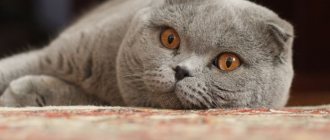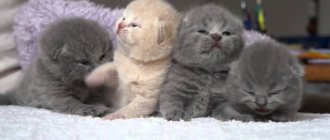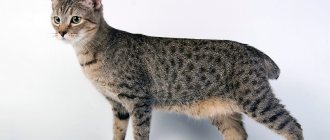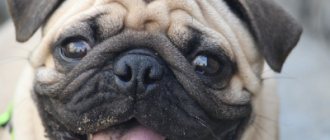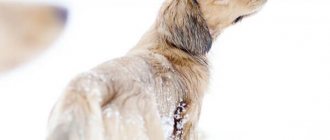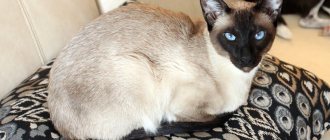The peculiarity of the Scottish Fold cat lies in the shape of its ears, which is not characteristic of other cats; it was once considered a defect, greatly transformed the animal and became the impetus for the creation of a new breed. It was formed with the participation of British and American Shorthair cats.
Not all world organizations enthusiastically accepted the breed with such non-standard ears. Only the CFA and WCF recognized Scottish Fold cats as a test breed in 1974, and four years later, at an elite exhibition in the USA, animals of this breed were met with rave reviews from felinologists and ordinary spectators. Since then, these charming cats began to fully participate in various types of exhibitions.
Breed varieties:
- Scottish Straights have a short coat and straight ears;
- Scottish Fold - short-haired with drooping ears;
- Highland Folds have long fur and ears close to the head.
- Highland Straights are long-haired with straight ears.
In addition to their unusual appearance, Scottish cats also have behavioral characteristics. They love to stand in a column on their hind legs. This is done not to attract attention or to see something better, but to warm up the spine. Another feature is their fear of heights, so they definitely won’t climb on cabinets or hang on curtains; these cats choose more aristocratic methods for their entertainment.
[advertising]
Description of breed standards:
- the body is of medium size, well-developed muscles, the maximum weight of a female is 4-5 kg, a male is 8-10 kg;
- the neck is short and strong;
- the legs are massive, the paws are oval-shaped;
- the tail is short and wide, tapering towards the tip;
- the head is spherical in shape with large plump cheeks, a massive chin and a flattened, humped nose;
- the ears are small, adjacent to the head, rounded at the ends;
- the eyes are large and set wide apart;
- The fur is thick and plush.
Kittens are born with straight ears. Only when they reach the age of 4-5 months can they change their shape and lie on their heads. The shape of their pressing to the head can also be different. Single, double or even triple folding of the ears stands out. The most valuable and expensive of all is the Scottish Fold cat, which has a triple fold of ears that fit snugly to the head, following its contour. Kittens whose ears have not drooped by the time they reach a certain age remain with straight ears for the rest of their lives. The pattern of this process has not yet been clarified, so the number of Scottish Folds in a litter is unpredictable.
Brief description of the breed
The official name is Scottish Fold, or Scottish Fold cat.
Country and time of origin of the breed: Scotland, Great Britain, 1961. The breed was officially registered in 1994.
The average weight ranges from 4 for cats to 7 kg for cats.
Life expectancy is from 12 to 15 years.
Cats of this breed are distinguished by their friendly and flexible character. They do not like loneliness, have high intelligence, and are easy to train.
In addition to its unusual appearance for cats, the Scottish Fold cat has the habit of standing up on its hind legs, resembling a meerkat at this point. In this way, animals unload their spine.
They also have the characteristic feature of making sounds that are more like squeaking than meowing.
Scottish Folds do not like to climb to great heights and are known for their cleanliness. They will always groom only in the litter box.
The main breed characteristic of an animal is the characteristic shape of the ears, which should be curved forward and slightly downward, without protruding above the contour of the animal’s head.
Weight by month
The average weight of Scottish Folds is 3.5-6 kg (males are larger than females).
| Age | Female (kg) | Male (kg) |
| 1 month | 0.35 — 0.6 | 0.4 — 0.7 |
| 2 | 0.45 — 0.75 | 0.8 — 1.6 |
| 3 | 1.2 — 1.65 | 1.35 — 2.45 |
| 4 | 1.7 — 2.3 | 2.1 — 3.8 |
| 5 | 2.2 — 3.2 | 2.4 — 4.2 |
| 6 | 2.3 — 3.6 | 2.9 — 5.56 |
| 8 | 2.8 — 4.3 | 3.45 — 6.2 |
| 10 | 3 — 4.64 | 4.2 — 7.2 |
| 12 | 3.2 — 5.4 | 4.6 — 7.4 |
| 24 | 3.44 — 5.6 | 5.4 — 8.2 |
History of the origin of the Scottish Fold cat breed
The breed was killed by accident in the early 1969s in Scotland. The fold-eared cat was first mentioned in ancient Chinese sources. Unlike the Scottish ones, they had long white wool. Before the advent of Scottish Folds, such cats were even called Chinese, but such a breed was not found in Europe.
The first cat with floppy ears was born in Scotland in 1961 to one of the local farmers. The owners named the unusual kitten with floppy ears Susie. Her mother was an ordinary semi-wild tabby, and her father was unknown. Susie began bringing in kittens with unusual floppy ears.
In 1963, one of these kittens was adopted by Mary Ross, who named her pet Snooks. This cat's first litter was a white kitten that looked like a Chinese fold cat. Ross decided to develop a new breed by crossing the offspring of Snooks with a British Shorthair cat, and Snooks herself with a British blue cat. It is from these lines that the new breed of Scottish Fold cats originates.
Later, scientists found a gene that is responsible for the stable shape of drooping ears. Selection work has shown that cats and cats with floppy ears produce sick offspring that suffer from diseases of the musculoskeletal system.
Therefore, when breeding such a breed, one parent with erect ears is always chosen. Only in this case will a healthy litter of Scottish Folds be obtained. Until recently, when compiling pedigrees, parents with erect ears were recorded as British Shorthairs. Recently, breeders have begun to indicate a separate type of domestic cat involved in the breeding of Scottish Folds - the Scottish Shorthair, or Scottish Straight. The only thing that distinguishes them from the Scottish Fold is their erect ears. Today, breeding fold cats are obtained only by mating folds with straights. Only in this case it is possible to completely preserve all the breed characteristics and good health of the kittens.
Purchasing a kitten
If you plan to purchase a kitten from a nursery, most likely it will be completely healthy and will have all the necessary documents, including a veterinary passport. However, it will cost 15 - 50 thousand rubles or more (depending on the color, title of the parents and the authority of the nursery).
You can purchase a kitten in the following nurseries that specialize in breeding this breed:
- SuperFold (Moscow);
- Rumfold (Moscow);
- Mouse Nightmare (Novorossiysk);
- S-Fold (St. Petersburg);
- Life Joy (St. Petersburg).
You can buy a fold kitten without documents from a private breeder. The price will be significantly lower - 2 - 5 thousand rubles. But in this case, carefully examine the kitten and make sure that it is healthy. When choosing a pet, pay attention to the flexibility of its paws and the mobility of its tail to exclude osteochondrodystrophy. Eversion of the eyelids and malocclusion can also be determined visually.
Appearance
Due to the youth of the breed, which is no more than 60 years old, the history of its exhibitions is still short. Breeders have so far only come up with a general standard that all Scottish Fold cats must meet.
When assessing breed data, judges at exhibitions use three systems of standards:
- WCF;
- CFA;
- TICA.
Only those that meet these parameters of the general breed standard, which are presented below, can be considered Scottish Folds.
Head
The animal's head should have a round shape with a pronounced massive chin, rounded cheeks and a high forehead. An adult cat may have sagging cheeks. For the nose of the Scottish fold, a wide short shape is recognized.
Ears
The ears may be small or medium in size with unpronounced tips. Their placement on the head should be wide. They should only fold forward and down.
An important feature of the breed is the correct shape of folded and flattened ears. The ears should not protrude above the outline of the animal's head.
Breeders distinguish three forms of floppy ears in Scottish Folds:
- single, when only the tip of the ear is bent;
- double, in which the entire shell is bent, leaving a small gap between the head and the hanging ear, which is clearly visible;
- triple, which is characterized by a completely repressed auricle. In this case, it seems that the cat has no ears at all.
Eyes
The eyes have a round characteristic shape, reminiscent of an “owl’s gaze.” It is very important that the eye color matches the coat color of the Scottish Fold.
Neck
The neck should be short and muscular.
Torso and limbs
The body of a Scottish Fold cat should be of medium size with well-developed muscles. It should have developed and well-defined shoulders and a broad chest.
Limbs with developed muscles of medium length and with small rounded paws.
Tail
The tail should have a wide base and be medium to long in size. The wide base should gradually taper towards the end of the tail and have a distinct curve at the tip. The tail should be flexible and mobile.
Wool
The cat's fur should be thick, tightly lying and elastic. The high density of the fur does not allow it to adhere tightly to the skin, so the cat appears fluffy even with short hair. There is also a standard half-length coat, which has the same characteristics.
Color
The coat of the Scottish Fold can be of different colors. There are standards for the combination of hair color, eye color, nose color and paw pads. White folds require the nose and paw pads to be pink and the eye color to be blue or gold.
Black Scottish Folds should have golden eyes, a black nose and black paw pads.
Individuals with a smoky black color should have only golden eyes, and black nose and paw pads.
Different coat colors are a characteristic feature of this young cat breed. For each type of coloring there is its own standard of pigmentation requirements for the coat, nose, eyes and skin on the paws.
Scottish Folds are a medium-sized cat breed. The female grows to 3.5-4.5 kg. The weight of males can reach 6-7 kg.
Pet health
In general, cats of this breed have good health, but are sometimes susceptible to certain diseases. Often, pets suffer due to improper mating when Scottish Folds are mated with each other, which is absolutely forbidden to do. The list of common diseases includes:
- entropion of the eyelid;
- allergy;
- deafness.
In addition to the above diseases, Scots in adulthood have problems with the digestive tract and the functioning of the cardiovascular system. To avoid them, you need to monitor your pet’s condition and take him to the veterinarian more often.
Character of Scottish folds
While most cat breeds get used to their place of permanent residence, Scottish Folds, like dogs, also become attached to their owner.
This is explained by the fact that the breed was originally bred as a domestic dog. Fold cats have never lived in a semi-wild state, so attachment to humans is inherent in them at the genetic level.
The Scottish Fold can be kept perfectly in a city apartment. She is not drawn to walks in the fresh air, although they will not bother her. If the owners periodically take the Folds out to the dacha, they will not cause them any disturbance: the cat will stay close to the owner all the time, not trying to run away.
When buying a kitten of this breed, you should immediately understand that Scottish Folds are very attached to their owner and are very impressionable. Various unexpected changes may come as a shock to them:
- rearrangement of furniture in the apartment, which representatives of all cat breeds do not like;
- long absence of the owner;
- owner's inattention.
They experience loneliness very much, as well as physical pain. Because of this, they may become depressed. Small kittens and teenage cats are especially sensitive to human attention. They need daily positive communication with their owner, otherwise the animal may get sick.
Representatives of this breed have a calm and balanced character. Folds are distinguished by their patience and affectionate attitude towards people. Sometimes you can notice a certain phlegmatic nature in their character.
Aggressive behavior is not considered a breed trait. Scottish folds never clash, which is why some people consider them cowardly. In fact, this is a breed character trait.
Representatives of this breed are true gentlemen. They prefer not to notice the one who initiates the conflict. If a difficult situation arises, the Scottish Fold cat can always fight back the offender.
This breed is suitable for families with small children. Fold will never scratch a child if the baby pesters him and squeezes him in his hands. A cat of this breed will delicately try to move away from the child instead of fighting back.
Scottish Folds get along well with dogs and even rodents, although they will still have hunting instincts. At the most unexpected moment, this animal, which at times seems passive and slow, likes to stretch its legs. To do this, he needs to build a special “sports corner” where the Scottish Fold can stretch his muscles.
A feature of this breed is practicality, which is rarely seen in representatives of other cat breeds. Fold-eared individuals can distinguish information that comes to them from the outside world and use it to their advantage. This feature of mentality and character makes Scottish Folds highly trainable.
A characteristic feature of the breed, for which it is called voiceless, is the peculiar sound that the Scottish Fold makes. Their voice sounds more like a squeak than a traditional meow.
A Scottish Fold cat will decorate any home. She is distinguished by her beauty and grace. At a young age, all individuals are playful. Adult cats are sedate and calm, with a sense of real aristocracy.
Cats of this breed love to stand in a column position on their hind legs and sleep on their backs, which generates a lot of affection from all people. A muzzle with an owl's gaze leaves no one indifferent and gives a lot of positive emotions.
Cats of this breed fit perfectly into large families and become faithful companions to lonely people. Representatives of this breed especially appreciate the attention and care of a person, paying him in return with affection and love.
Disease Prevention
Proper care of the Scottish Fold, proper nutrition, taking a vitamin complex. There are special preparations that are made specifically for this breed.
Kittens are recommended to take a vitamin complex consisting of vitamins A and D for up to a year.
Care and maintenance
Scottish Folds are rightfully considered one of the cleanest cats. They do not require complex care like Persians. Representatives of this breed take care of their fur themselves. They very quickly get used to going to the tray and, if there is a scratching post, they will never damage the furniture. Representatives of this breed will not cause trouble to their owners in the form of scattered things or torn curtains. They will not climb on shelves and throw off everything that comes under their paw.
If Fold stays alone at home for a long time, you need to come up with activities for him, choosing toys for your pet. These can be soft imitations of mice or rubber toys with springs.
Cats of this breed need to create their own place in the house. This could be a cozy bed in the form of a basket, or a house with tiers of platforms on which the cat can stretch.
Grooming
In Folds, the coat can be short (Scottish Fold) or semi-long (Highland Fold), while always remaining thick and dense. Short hair is easier to care for. The cat should be brushed once a week with a special mitten or brush that uses natural bristles. Semi-long wool is combed out with a special metal comb, the teeth of which are coated with Teflon.
The cat needs to be washed once a month. If the animal is preparing for an exhibition, then this will need to be done more often. You need to use special shampoos, selecting them for a specific coat color.
Claw care
The claws of domestic cats need to be trimmed, being careful not to touch the living part of the claw. This should be done once or twice a month.
Ear and eye care
You should clean your ears when plaque appears in them. For this, cotton swabs and a special liquid are used, which should be purchased at a pet store. If the kittens' eyes are running, they are instilled with special drops.
Interesting facts about Scottishfolds
Finally, here are some interesting facts about cats of this wonderful breed.
- They appear more and more often in art. In the 1970 cartoon about Carlson, the cat Freken Bok Matilda is a fluffy Scottish Highland Fold.
- The breed has a kind of antipode. While the Scottish Fold has ears that are bent forward, the American Curl breed has ears that are turned back.
- Some owners note that the Scots are afraid of heights.
The Scottish Fold is a wonderful cat breed. Excellent character, fairly good health and charm conquer the heart at first sight. It is worth adopting a kitten if this is not the first animal in the family, or if you have children. It is important to contact a nursery or breeder with a good reputation, monitor the cat’s health and provide it with everything it needs.
Feeding: diet for adult Scottish Fold cats and kittens
You can feed Scottish Folds with natural or prepared food. You can also combine both types of feed. If owners choose ready-made cat food, they should give preference to proven food, following the manufacturer's recommendations when compiling portion sizes.
When combining ready-made and natural food, you should not mix two types of cat food. “Natural” can and should be mixed by including meat, cereals and vegetables in your pet’s diet. Your cat should always have water in his bowl.
Diet of adult cats
An adult cat needs to be provided with a complete protein diet. If the owner chooses natural food, then the Scottish Fold’s diet should always contain protein foods:
- lean meat;
- boneless fish;
- dairy products.
You also need to give crackers, bread and cereals, which will become sources of carbohydrates necessary for the animal.
Cats also need fats. To do this, eggs and vegetable oil are added to the “natural”. Feeding should be carried out 2-3 times a day. The animal should eat in small portions.
It is necessary to ensure that the fold-eared cat does not overeat, otherwise it may gain extra pounds, which will negatively affect the pet’s health. An adult cat needs 250 kcal per day, and a male cat needs 300 kcal.
Kittens menu
To feed small lop cats, you need to carefully select the diet so that the pet grows and develops normally. The health and appearance of a purring cat with drooping ears directly depends on the quality of nutrition.
Kittens up to three weeks of age are left on the cat's breast milk. After which their complementary feeding begins. To do this, they are given goat's or cow's milk, to which a little sugar is added.
At week 8, you can offer your babies cottage cheese, porridge mixed with yolk, boneless meat and fish, and vegetable puree. At the sixth month, kittens are transferred to the diet of an adult cat and fed 3 times a day, gradually reducing the amount of milk.
Kittens should regularly add vitamin supplements to their food if they are fed natural food.
Diseases
This breed has diseases that can be inherited. These include :
- diseases of the musculoskeletal system;
- polycystic kidney disease;
- pathology of the heart muscle.
Bone problems have symptoms such as lameness, hard tail tip, and stiff joints. When the first symptoms appear, you should immediately contact your veterinarian.
Scottish Folds should also be vaccinated every year. The first vaccinations are given at 2-3 months. If the owners did not have time to vaccinate the pet at this time, then they should definitely vaccinate after the change of milk teeth. Repeated at this age is done after two weeks.
Cats are vaccinated against a number of dangerous diseases, which include:
- calcivirosis;
- panleukopenia;
- rhinotracheitis;
- chlamydia.
Before vaccination, you need to worm the kitten. This is done 10 days before vaccination.
A rabies vaccination is also required. When self-walking, it is necessary to regularly treat the animal against fleas and ticks, using different preparations:
- sprays;
- drops;
- collars.
Proper vaccination will help prevent serious illnesses in pets.
Catering
You can choose to feed your pet: natural food or industrial ready-made food. But it is not recommended to mix one with the other: different enzymes are produced for processing different types of feed, and by complicating the process, you unnecessarily burden the stomach.
Natural products
From natural food you can give:
- Pre-frozen lean meat: veal, beef, turkey, rabbit, lamb, chicken. When cooking, some of the beneficial substances are destroyed, so processing should be minimal. Be sure to pour boiling water over raw meat before serving: this procedure will destroy parasites and their larvae and eggs.
- Fish: trout, hake, salmon, flounder, tuna, navaga. But not more than once a week (excess fish provokes the development of urolithiasis.
- Dairy products: unsalted hard cheese, low-fat cottage cheese, natural yogurt without additives, sour cream, fermented baked milk, yogurt, Varenets.
- Boiled chicken yolk, boiled quail eggs.
- Porridge: rice, millet, buckwheat, oatmeal, pearl barley, semolina. Porridge is cooked in water without sugar, salt or seasonings, adding a little bit of any vegetable oil (half a teaspoon of olive, flaxseed, sunflower).
- Vegetables: broccoli, zucchini, carrots, pumpkin, asparagus, green beans, celery. As a treat: watermelons, melons, cucumbers, apples.
A separate bowl should always contain clean water at a comfortable drinking temperature. Do not feed your cat directly from the tap: tap water is too hard, saturated with salts, bleach and other components dangerous to the animal.
You cannot give:
- fatty, smoked, salty, sweet, sour, spicy, pickled;
- alcohol, compotes, juices, mineral water, tea, coffee;
- dog food;
- human canned food;
- products containing cocoa, seasonings, spices, ketchups;
- eggplant, avocado, onion, garlic, raisins, legumes.
Recommended food
Among ready-made foods, it is better to give preference to holistic foods AATU, Applaws, Canagan, Natural and super-premium Leonardo, Mealfeel, Meowing Heads. Premium and economy class food is made from low quality products, their composition is poor, there are no vitamins and minerals, but there is an abundance of dyes and questionable components.
Below are recommended super-premium foods. Links with the names of the food are clickable, on them you can, within our website, get acquainted with the descriptions of the food and read reviews from owners of Scottish Fold cats.
| Holistic | Super premium | Super premium |
| Acana | Karmy | Landor |
Owners' opinion
Owners of Scottish Folds often leave comments about their pets. Most owners speak positively about their favorite plush cats. As a rule, they are balanced, intelligent and beautiful. The Scots are kind to all people and animals. But owners often write about problems associated with this breed. These include high activity of the pet at a young age, disobedience, ignoring family members, damage to furniture and fragile health.
Often, most of the problems that a cat creates are the fault of the owner himself, who did not react in time and did not show the pet how to behave correctly. When it comes to health, you need to carefully monitor the condition of the animal and not leave the situation to chance.
Scottish Folds are the smartest and most graceful creatures that, with proper training and care, will be excellent pets.
Chinchilla
The Scottish chinchilla borrowed the extravagant colors of its coat from the British, and they, in turn, from Persian cats. A chinchilla kitten is born only from parents with an unusual color. Each hair is colored in two colors.
Most of it is light in color and 1/8 of it (the top) is dark in color. This phenomenon is called tipping.
Tipped chinchilla colors can be of 3 types:
- Golden. The cat has a white undercoat. But on top there is a reddish coating over almost the entire surface of the body (on the sides, back and tail of the animal). Only the beard, the tips of the ears and the belly are white. Yellow-gold eyes, pink pads and a brick-colored nose.
- Silver. White wool coated with silver gives an interesting gray effect. The color of the tail has a hint of stripes, the nose is beige, and the eyes are green. Snow-white tips of the pet's ears, chin and belly.
- Blue golden. The rarest and therefore valuable color of Scottish chinchillas. The undercoat is a delicate caramel color, and the tips of the hair are a radiant blue hue. The eyes are natural emeralds of a rich green tone.



